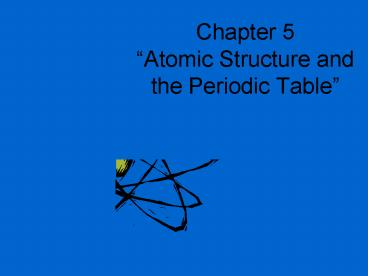Chapter 5 - PowerPoint PPT Presentation
1 / 23
Title:
Chapter 5
Description:
Chapter 5 Atomic Structure and the Periodic Table What is an atom? What is an element? How are elements named? What is the most abundant element in the universe? – PowerPoint PPT presentation
Number of Views:121
Avg rating:3.0/5.0
Title: Chapter 5
1
Chapter 5Atomic Structure and the Periodic
Table
2
BellRinger- 1/11/10
- What is an atom?
- What is an element?
- How are elements named?
- What is the most abundant element in the
universe? - What is the most common element in the human body
and in the Earths crust?
3
Atomic Structure
Atoms are made of three sub-atomic particles
1._____________
2._____________
3._____________
protons
neutrons
electrons
4
- This central part is called the ___________.
- The central part of the atom contains the
- _________ and _________.
- Protons have a ___________charge.
- Neutrons have ________ charge.
nucleus
protons
neutrons
positive
no
positive
- The nucleus has an overall ________ charge.
- The strong __________ __________ holds
- protons and neutrons together in the nucleus.
nuclear force
5
- Electrons (e-) are moving around an area
- called the ________ ______.
electron cloud
negative
- Electrons have a _________ charge.
- The electron cloud has a _________charge.
negative
The e- cloud is usually 10,000 times larger than
the nucleus.
HOWEVER
6
- protons and neutrons weigh about
0.00000000000000000000000167 g - electrons weigh about
0.00000000000000000000000000091 g
To you and me, protons/neutrons are about 2000
times HEAVIER than electrons!!!!!
7
Exit Slip Copy and answer the following
questions on a sheet of loose- leaf paper. Turn
in your paper as you leave the classroom.
- Which subatomic particles are found in the
nucleus of the atom? - What is the overall charge of the nucleus of the
atom? - What is the overall charge of the electron cloud?
- Which part of the atom makes up most of mass of
the atom? - Which part of the atom has the greatest volume?
- Draw and label the picture of the atom.
8
The Periodic Table
A table that shows a periodic or repeating
pattern of properties of the elements
9
History of the Periodic Table
- Russian chemist, Dmitri Mendeleev, produced
the first periodic table in 1869 - Elements with similar properties were arranged
in rows in order of increasing atomic mass.
10
The Modern Periodic Table
- Includes over 100 elements that make
- up everything we see and touch
- Elements with similar properties
- are found in columns.
- Arranged by increasing atomic number
- Three types of elements metals, nonmetals,
- and metalloids
11
Reading the Periodic Table
Each square on the periodic table gives
particular information about the element.
50 Sn Tin
118.71
Atomic Number -------- Chemical Symbol
-------- Element Name --------- Atomic mass ---
12
Atomic Number - the number of protons in an
element In a neutral atom, the number of
electrons is equal to the number of
protons. Chemical Symbol- an abbreviation of the
elements name. It has one to three letters.
First letter is always capitalized. Atomic Mass -
the average mass of all the isotopes of an
element. Isotopes - elements with the same number
of protons, but DIFFERENT numbers of
neutrons. Examples include chlorine-37,
chlorine-35, carbon-14 (37 atomic mass number
35 atomic mass number 14 atomic mass number)
13
Atomic Mass Number The total number of protons
and neutrons in the nucleus of an atom. Round
the atomic mass to the nearest whole number.
The number of neutrons equals atomic mass number
minus atomic number.
14
8 O 15.9994
This elements atomic number is 8. How many
protons does it have? ___
8
If its atomic mass number were 14, how many
neutrons would it have?
8 protons _?_ neutrons 14 atomic mass
number Also remember, atomic mass number minus
atomic number equals number of neutrons.
6 neutrons
15
79 Au 196.967
How many protons does gold have? ___
79
How many electrons ?
79
How many neutrons?
118 neutrons
16
Exit Slip Copy the table and enter missing
information.
Carbon-14
17
Copy the table and enter missing information.
Chlorine-37
18
Pre-AP BellRinger 1/14/10
- Copy and answer the following question
- The atomic number is the number of neutrons in an
atom. - The electron cloud makes up most of the volume of
an atom. - The atomic mass is the average mass of all the
isotopes of an atom - The modern periodic table is arranged according
to increasing atomic mass. - Which of the statements is/are true about atoms
and the periodic table? - I and II only
- I, II, and III only
- II and III only
- I, II, III, and IV
19
- Period -
- A horizontal row on the periodic
- table.
- The periodic table has 7 periods.
- The period number tells us how
- many energy levels an atom has.
20
- Group-
- A vertical column on the periodic table.
- Also called a family of elements
- Elements share similar physical and
- chemical properties.
- The family number tell us how many
- electrons an atom has in its outermost
- energy level or shell (valence electrons).
21
Family/Group Number Number of Valence Electrons
1 1
2 2
3-12 1 or 2
13 3
14 4
15 5
16 6
17 7
18 8
22
Bohr Model of the Atom Each e- shell can only
hold a certain number of electrons.
2
1st ring up to __ e-
8
2nd ring up to __ e-
18
3rd ring up to __ e-
32
4th ring -- up to ___ e-
protons and neutrons are located in the nucleus
23
Bohr Model Practice
Draw a Bohr Model for each of the following
atoms Carbon Lithium Calcium Argon
2e-
3 P 3 N0
1 e-
Example































